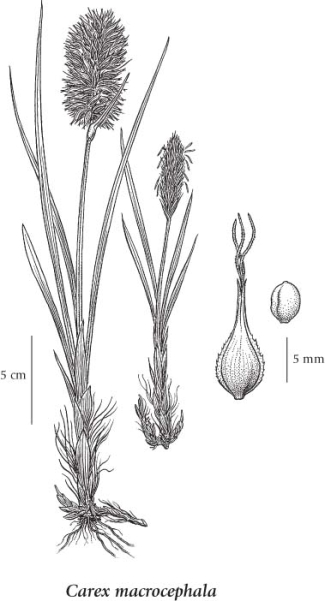large-headed sedge (big-headed sedge)
Cyperaceae (Sedge family)
Introduction to Vascular Plants
Photograph
© Dawn Hanna (Photo ID #10551)
Introduction
Large-headed sedge is a distinctive coastal species of perennial, rhizomatous sedge that is found in North America and Asia in coastal dunes and beaches. In North America, it is restricted to the Pacific Coast, where it is reported from Alaska, British Columbia, Washington and Oregon (USDA 2011). It has also been reported from New Jersey (Wooton 2007) where it is potentially invasive. In British Columbia, this species has been reported along the coast from the US border north to Haida Gwaii.
This is an easily recognized, low-growing (10-30 cm tall) species of Carex that stands out in beach/dune habitats and is usually dominant. It may be found with other beach/dune specialists such as beach pea (Lathyrus japonicus var. maritimus). The large brown seed heads and sharply angled stems are distinctive. Populations of this species may be viewed in the Vancouver area at Iona Beach Regional Park (Richmond) and Boundary Park Regional Park (Delta). |
Species Information
General:
Perennial herb from long, spreading rhizomes; stems 10-30 cm tall, arising singly or a few together, usually shorter than the leaves.
Leaves:
Sheaths brownish or blackish, breaking into threads at the bases, persistent; blades 2 to 5 per stem, channeled, gradually tapering to the tips, 4-8 mm wide.
Flowers:
Spikes either male or female, unstalked, the male inflorescence with many aggregated spikes in a cylindrical, 3.5- to 5-cm long by 1- to 1.5-cm wide head, the female inflorescence with many aggregated spikes in a cylindrical to egg-shaped, 3.5-8 cm long by 2.5-5 cm wide head; bracts lacking in the male inflorescence, the female inflorescence with several to numerous bracts enlarged at the bases, with small-bristled teeth, up to 6 cm long.
Fruits:
Perigynia lanceolate to egg-shaped, 1-1.5 cm long, 4-6 mm wide, brownish to brownish-yellow, plano-convex, with small-bristled teeth above, shiny, strongly nerved on both faces, crowded, ascending to spreading, short-stalked, the beaks 5-7 mm long, as long as the bodies of the perigynia, bidentate; female scales egg-shaped, dark to light brown, with translucent margins, usually shorter and narrower than the perigynia; stigmas 3; achenes lens-shaped, 3.5-4 mm long.
Illustration

If more than one illustration is available for a species (e.g., separate illustrations were provided for two subspecies) then links to the separate images will be provided below. Note that individual subspecies or varietal illustrations are not always available.
Illustration Source: The Illustrated Flora of British Columbia
Ecology
The table below shows the species-specific information calculated from
original data (BEC database) provided by the BC Ministry of Forests and Range.
(Updated August, 2013)
| Site Information |
Value / Class |
||
|
Avg |
Min |
Max |
|
| Elevation
(metres) |
818 | 0 | 1970 |
| Slope
Gradient (%) |
15 | 0 | 72 |
|
Aspect (degrees) |
189 | 42 | 270 |
| Soil
Moisture Regime (SMR) [0 - very xeric; 4 - mesic; 8 - hydric] |
3 | 1 | 7 |
| Modal
Nutrient Regime
Class |
C | ||
| #
of field plots species was recorded in: |
15 | ||
| Modal
BEC Zone Class |
CWH | ||
|
All BEC Zones (# of stations/zone) species was recorded in |
BAFA(2), BWBS(1), CWH(5), ESSF(1), SBS(3), SWB(3) | ||
|
Source:
Klinkenberg 2013
|
|||
Habitat and Range
Sand beaches and dunes in the lowland zone; infrequent in coastal BC; amphiberingian, N to AK and S to OR; coastal E Asia.Status Information
Synonyms
Synonyms and Alternate Names:
Carex anthericoides
Carex macrocephala subsp. anthericoides